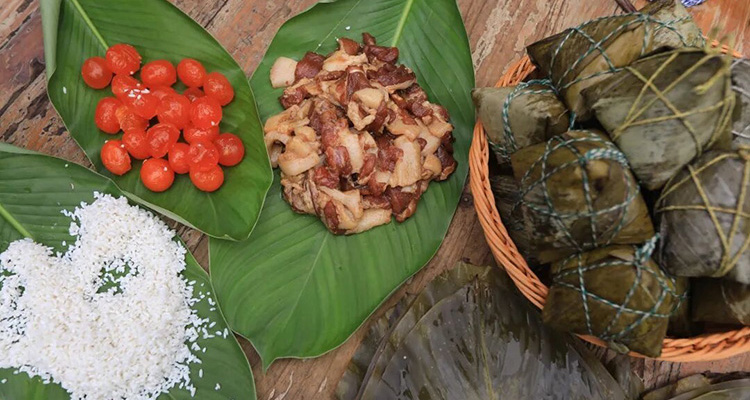Ding’an Zongzi: Hainan’s Savory Rice Dumpling
In the coconut-fringed landscapes of Hainan, Ding’an Zongzi offers a memorable taste of the island. More than a Dragon Boat Festival treat, these glutinous rice dumplings combine selenium-rich glutinous rice, salted duck egg yolk, and braised pork, wrapped in regional leaves. Each bite is soft, savory, and richly aromatic—a true Hainan specialty.
1.The island’s century-old flavor: origins and heritage
Ding’an Zongzi traces back to the Ming dynasty and has become one of Hainan’s three famous zongzi. Locally it evolved from farming life: villagers used regional leaves to wrap rice and meat for preservation and portability during hot summers and long workdays. In 2009, “Ding’an Zongzi” received national geographic indication protection, recognizing its unique taste and cultural value.
2.Natural gifts that shape the ingredients:
selenium-rich rice and island flavors
The distinctive taste starts with the ingredients. Core to Ding’an Zongzi is the selenium-rich glutinous rice grown in Ding’an County—plump, tender, and excellent at absorbing fillings. The filling typically uses local black pork, balanced fat and lean, marinated to deep flavor, plus red-hearted selenium-rich salted duck eggs with rich, oily yolks. Rather than common reed leaves, the dumplings use Hainan’s eggplant-leaf or holly-like leaves, which impart a subtle plant aroma during cooking and add a touch of tropical character.

3.The craft of hand-wrapping: traditional preparation revealed
Making Ding’an Zongzi is a hands-on craft passed through generations. The process values technique and timing. Soaked glutinous rice is drained and ready; pork is cut into bite-sized pieces and marinated with salt, soy, and rice wine; salted duck egg yolks are removed intact. Two washed regional leaves are crossed to form a pocket, layered with rice, a piece of pork, and an egg yolk, then topped with more rice. Skilled hands fold the leaves into a cone or rectangular shape and bind them tightly with hemp or grass twine to prevent leakage during boiling. The bundles simmer for hours over fire or on a stove, filling the air with the leafy, meaty aroma.
4.A feast for the palate: layers of flavor and texture
A cooked Ding’an Zongzi reveals steaming, slightly yellow-tinted rice—proof of yolk and pork fat infusion. The rice is soft and pleasantly sticky; the salted yolk is sandy and oily, delivering savory richness. The pork becomes tender and melts into the rice, with lean fibers infused with marinade and the fat adding moisture. The regional leaf’s fragrance lends a fresh herbal note that balances the richness. The overall profile is savory and aromatic, rich but not greasy, with a complex interplay of ingredients.
5.How to enjoy this Hainan delicacy
Ding’an Zongzi is best eaten hot. Open the leaf-wrapped parcel straight from the pot to enjoy the fullest aroma. Eat it plain to experience the original flavors or dip into a bit of Hainan chili sauce for a spicy lift. Locals often pair a zongzi with a bowl of plain congee or some blanched greens for a satisfying meal. Because of its hearty nature, these dumplings are shareable and commonly sold year-round as a local specialty beyond the Dragon Boat Festival.

6.Traveler tips: where to find the most authentic Ding’an taste
To taste the most authentic Ding’an Zongzi, head to Ding’an County. Old neighborhoods, family workshops, and time-honored shops make traditional versions passed down through generations. Larger cities in Hainan like Haikou and Sanya sometimes sell Ding’an Zongzi in specialty stores or restaurants—look for the geographic indication label when buying. Visiting during the Dragon Boat Festival offers chances to watch or join lively zongzi-wrapping events. Packaged properly, these dumplings also make excellent edible gifts.
7.Recreate the island flavor at home: a simple home recipe
If you can’t travel to Hainan immediately, try a simple home version. Use glutinous rice, salted duck egg yolks, and pork belly; substitute large bamboo or reed leaves if regional leaves are unavailable. Soak the rice for at least four hours; marinate pork overnight with soy, dark soy, and five-spice. Soften leaves by boiling, then layer rice, pork, and yolk, wrap tightly, and tie. Boil submerged for 3–4 hours on low. Homemade zongzi may differ from the Ding’an original but deliver a satisfying taste of the island.

A single Ding’an Zongzi captures Hainan’s soil, sun, and culinary tradition. When you visit this tropical island, seek out this preserved flavor—let the soft, savory rice dumpling reveal an authentic taste of Hainan.



